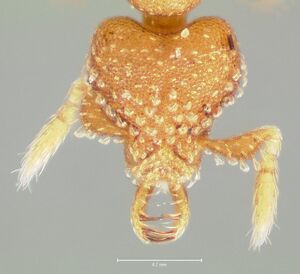Strumigenys lutron
| Strumigenys lutron | |
|---|---|

| |
| Scientific classification | |
| Kingdom: | Animalia |
| Phylum: | Arthropoda |
| Class: | Insecta |
| Order: | Hymenoptera |
| Family: | Formicidae |
| Subfamily: | Myrmicinae |
| Tribe: | Attini |
| Genus: | Strumigenys |
| Species: | S. lutron |
| Binomial name | |
| Strumigenys lutron Fisher, 2000 | |
The dozen collections of this species are primarily from rainforest, with other habitats including littoral forest and a single savanna grassland record. All of the specimens have been obtained from litter samples.
Identification
Bolton (2000) - A member of the lutron complex in the Strumigenys arnoldi-group. S. lutron is immediately separated from other members of the arnoldi-group by having 4 antennal segments, pronotal humeral hair absent, and pronotal disk with densely reticulate punctate sculpture without distinct longitudinal costulae.
Keys including this Species
Distribution
Distribution based on Regional Taxon Lists
Malagasy Region: Madagascar (type locality).
Distribution based on AntMaps
Distribution based on AntWeb specimens
Check data from AntWeb
Countries Occupied
| Number of countries occupied by this species based on AntWiki Regional Taxon Lists. In general, fewer countries occupied indicates a narrower range, while more countries indicates a more widespread species. |

|
Estimated Abundance
| Relative abundance based on number of AntMaps records per species (this species within the purple bar). Fewer records (to the left) indicates a less abundant/encountered species while more records (to the right) indicates more abundant/encountered species. |

|
Biology
|
Castes
Worker
Images from AntWeb
   
| |
| Paratype of Strumigenys lutron. Worker. Specimen code casent0005594. Photographer April Nobile, uploaded by California Academy of Sciences. | Owned by CAS, San Francisco, CA, USA. |
   
| |
| Holotype of Strumigenys lutron. Worker. Specimen code casent0005595. Photographer April Nobile, uploaded by California Academy of Sciences. | Owned by MCZ, Cambridge, MA, USA. |
Nomenclature
The following information is derived from Barry Bolton's Online Catalogue of the Ants of the World.
- lutron. Strumigenys lutron Fisher, in Bolton, 2000: 633 (w.) MADAGASCAR.
Unless otherwise noted the text for the remainder of this section is reported from the publication that includes the original description.
Description
Worker
Holotype. TL 1.6, HL 0.39, HW 0.38, CI 98, ML 0.14, MI 36, SL 0.20, SI 53, PW 0.23, AL 0.42. Characters of lutron-complex. Mandible blade narrow, linear, outcurved; without intercalary denticles between the apical fork teeth. Right mandible with 2 preapical teeth, a short distal tooth and a spiniform proximal tooth located at about the apical third of the length; left mandible with at most a distal preapical denticle but proximal preapical tooth spiniform. Anterior clypeal margin broad, projecting beyond the mandibular bases on each side, with a feeble median impression and with numerous small spatulate to spoon-shaped hairs which are curved towards the midline. Lateral margin of clypeus short. Preocular lamina broad, projecting below the antennal insertion. Median portion of clypeus broad, finely punctulate and with scale-like to spoon-shaped hairs present. Dorsum of head behind clypeus reticulate-punctate and with numerous broadly scale-like to spoon-shaped hairs on anterior two-thirds. Outer margin of frontal lobe and upper scrobe margin with a continuous row of scale-like to spoon-shaped hairs. Hairs on upper scrobe margin not terminating at the posterior end with a more or less straight clavate hair. Eye very small, with 3 ommatidia in total and situated just above the ventral scrobe margin. Antenna with 4 segments. Leading edge of the scape a dorsoventrally flattened convex lamella with a row of projecting scale-like to spoon-shaped hairs. Dorsum of head with a transverse row of 4 hairs close to the occipital margin. Pronotal humeral hair absent. Mesonotum with a pair of short filiform hairs on anterior margin (can be worn). In profile, the promesonotum slightly convex; propodeal dorsum shallowly convex anteriorly, sloping posteriorly to the declivity. Propodeal teeth very short, mostly incorporated in the lamellae, with only a small point projecting. Sides of alitrunk smooth to superficially reticulate-punctate. Dorsal alitrunk and at least the upper half of the propodeal declivity reticulate-punctate, the punctures more strongly defined and denser on the pronotum than on the propodeum, where they may be superficial. Ground-pilosity of dorsal alitrunk consisting of numerous small appressed hairs. In profile the petiole with a well developed spongiform lamella. Dorsal surface of petiole node finely punctate to reticulate, the postpetiole smooth. Petiole, postpetiole and gaster with short simple to narrowly clavate hairs. Colour dull yellow to pale brown.
Paratypes. TL 1.6-1.7, HL 0.39-0.41, HW 0.36-0.38, CI 92-96, ML 0.13-0.15, MI 33-39, SL 0.19-0.21, SI 52-57, PW 0.22-0.24, AL 0.41-0.45 (6 measured). As holotype.
Measurements of non-paratypic material extend the range shown by the type-series: HL 0.39-0.40, HW 0.38, CI 96-98, ML 0.15, MI 38-39, SL 0.20-0.21, SI 52-55 (2 measured).
Type Material
Holotype worker. Madagascar: Provo Toamasina, S. F. Tampolo; 10 km. NNE Fenoarivo Atn., 17°17'S, 49°26'E, 10 m., 4.iv.1997, sifted litter (leaf mold, rotten wood), littoral rainforest #1342 (49)-1 (B. L. Fisher) (Museum of Comparative Zoology).
Paratypes. 6 workers with same data as holotype but coded (21)-2, (34)-1, (36)-3, (42)-2, (47)-3 (The Natural History Museum, South African Museum).
References
- Fisher, B.L. 2000. The Malagasy fauna of Strumigenys. Pp. 612-696 in: Bolton, B. 2000. The ant tribe Dacetini. Memoirs of the American Entomological Institute. 65:1-1028. (page 633, worker described)
References based on Global Ant Biodiversity Informatics
- Bolton, B. 2000. The Ant Tribe Dacetini. Memoirs of the American Entomological Institute 65
- Fisher B. L. 2003. Formicidae, ants. Pp. 811-819 in: Goodman, S. M.; Benstead, J. P. (eds.) 2003. The natural history of Madagascar. Chicago: University of Chicago Press, xxi + 1709 pp.

